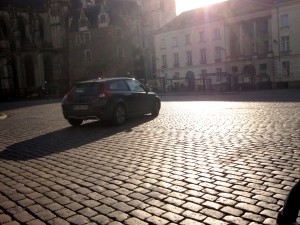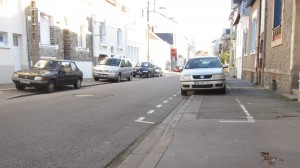“French cities just have a lot more layers,” I explained to my parents over skype.
“You mean, the buildings are more stacked up than in the U.S?” my dad asked.
That wasn’t what I had meant, although it is kind of true, if not vertically. French cities are generally very old. Most of them were established hundreds of years before anyone even though of telling the King of England to buzz off, and we’ll start our own country, thank you very much. Perhaps most easily, this history is seen in all of the beautiful old buildings.
While many buildings in the United States are still being used for their first intended purpose, I think most buildings in Nantes have changed hands, centuries, and purposes more than once. Sometimes, remodeling has introduced new fangled things like pipes through which we send water, or a series of tubes through which we send the internet. If bathrooms weren’t in the original plan, you make do with the nooks and crannies you can find.
Outside of the buildings are the ancient streets. Many have been carrying traffic since long before Honest Abe was born, and perhaps even before the Anglo-Saxons produced the word honest in that form. Since the car is even younger than Abraham Lincoln, sometimes they don’t have room to keep them on the street, so they use the sidewalk too.
There are also tons of cobblestone streets here in Nantes, something I absolutely love. Some of them are modern, but I think some of them date from quite some time ago.
What I meant by the layers of French cities goes beyond the buildings though. I guess it goes beyond the cities as well. The physical layers of buildings (not always vertical layers though), the streets, the changing of landscapes is only a physical manifestation of something deeper. There is more history in France. The layers are not just in the buildings, but the language, the manners, the inclinations of the people. France is an old country, but more importantly, the French are an old people.
There are two ways of addressing people in the language, which indicate different levels of formality. Their food is more of a ritual than in the United States. They have a much more single, unified culture and identity than that of the United States. There are many laws and elements of the society implemented by Napoleon which still apply today, even though several new governments have come and gone in the interim.
It was once said to me that the richness of the United States and France lies, respectively, in our land and their history. In the United States, we have many national parks and protected wilderness. Our natural resources are some of our greatest treasures. While France has stunning countryside, its government goes to great lengths protecting the innumerable monuments, historical sites, and works of art that have been produced over its long history. Living here, seeing the museums, the cities, and the people I can begin to understand what the national treasure of France is: their long, rich history, full of layers in buildings, cities, people and culture.

This isn't a great picture, but that's the point. I didn't try, and yet there are at least four different interesting elements: the first is the modern car, the second the wide space full of cobble stones. In the back, just above the car, you can make out what remains of the ancient walls of Nantes. Behind that, and harder to see, is the very old cathedral.



